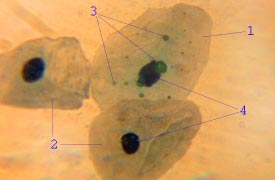Vaginal epithelium
Vaginal Epithelium[edit | edit source]
The vaginal epithelium is the innermost layer of the vaginal wall, consisting of stratified squamous epithelial cells. This layer plays a crucial role in protecting the underlying tissues and maintaining the health of the vaginal environment.
Structure[edit | edit source]
The vaginal epithelium is composed of multiple layers of cells that provide a barrier against pathogens and physical abrasion. The surface layer consists of flattened, keratinized cells, while the deeper layers contain more cuboidal and columnar cells. This stratification is essential for the protective function of the epithelium.
Function[edit | edit source]
The primary function of the vaginal epithelium is to protect the vaginal tissues from mechanical damage and infection. It also plays a role in maintaining the vaginal pH and microflora, which are crucial for preventing infections.
Glycogen and Microflora[edit | edit source]
The epithelial cells contain glycogen, which is metabolized by lactobacilli to produce lactic acid. This process helps maintain an acidic environment in the vagina, inhibiting the growth of pathogenic bacteria.
Clinical Significance[edit | edit source]
Changes in the vaginal epithelium can be indicative of various medical conditions. For example, thinning of the epithelium is associated with vaginal atrophy, often seen in postmenopausal women. Infections such as Chlamydia trachomatis can also affect the epithelial layer.
Histology[edit | edit source]
Histological examination of the vaginal epithelium reveals its stratified squamous nature. The presence of glycogen-rich cells is a characteristic feature, which can be observed under a microscope.
Related Pages[edit | edit source]
Search WikiMD
Ad.Tired of being Overweight? Try W8MD's physician weight loss program.
Semaglutide (Ozempic / Wegovy and Tirzepatide (Mounjaro / Zepbound) available.
Advertise on WikiMD
|
WikiMD's Wellness Encyclopedia |
| Let Food Be Thy Medicine Medicine Thy Food - Hippocrates |
Translate this page: - East Asian
中文,
日本,
한국어,
South Asian
हिन्दी,
தமிழ்,
తెలుగు,
Urdu,
ಕನ್ನಡ,
Southeast Asian
Indonesian,
Vietnamese,
Thai,
မြန်မာဘာသာ,
বাংলা
European
español,
Deutsch,
français,
Greek,
português do Brasil,
polski,
română,
русский,
Nederlands,
norsk,
svenska,
suomi,
Italian
Middle Eastern & African
عربى,
Turkish,
Persian,
Hebrew,
Afrikaans,
isiZulu,
Kiswahili,
Other
Bulgarian,
Hungarian,
Czech,
Swedish,
മലയാളം,
मराठी,
ਪੰਜਾਬੀ,
ગુજરાતી,
Portuguese,
Ukrainian
Medical Disclaimer: WikiMD is not a substitute for professional medical advice. The information on WikiMD is provided as an information resource only, may be incorrect, outdated or misleading, and is not to be used or relied on for any diagnostic or treatment purposes. Please consult your health care provider before making any healthcare decisions or for guidance about a specific medical condition. WikiMD expressly disclaims responsibility, and shall have no liability, for any damages, loss, injury, or liability whatsoever suffered as a result of your reliance on the information contained in this site. By visiting this site you agree to the foregoing terms and conditions, which may from time to time be changed or supplemented by WikiMD. If you do not agree to the foregoing terms and conditions, you should not enter or use this site. See full disclaimer.
Credits:Most images are courtesy of Wikimedia commons, and templates, categories Wikipedia, licensed under CC BY SA or similar.
Contributors: Prab R. Tumpati, MD










